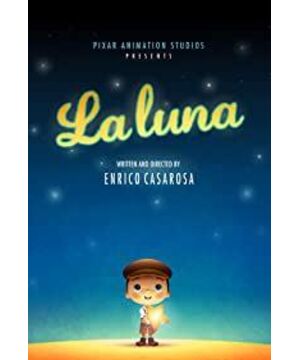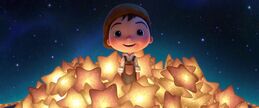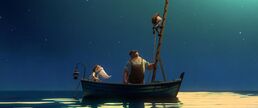Produced by Disney and Pixar, "Luna" tells a series of stories in seven minutes when three generations of grandparents clean up the stars on the moon. Under the director's ingenious rhythm arrangement and romantic colors, it outlines a warm but romantic scene. A child's learning and growth experience that gives people thinking.
In general, the film mainly has two rhythm points, which can be divided into three parts. The film begins on a horizontal plane, and the title "La Luna" is cleverly dropped on a flat boat that has been rowed over and is projected into the audience's eyes. After several alternate medium shots and panoramas, the people on the boat under the overhead shot appear small and lonely. When we arrived at our destination and waited quietly for the moon to rise, the first rhythm point of the film and the first contradiction arose, that is, how the grandfather and father put hats on the children and the choice of cleaning tools after landing on the moon. dispute. And this kind of dispute is also about the different views on children's education and way of doing things. At this time, the child has no ideas of his own, and is just a doll at the mercy of his father and grandfather. When the dispute subsided, he began to try to imitate or learn from the actions of the two elders. The two scenes of his father and grandfather's actions that he imitated were shot upwards, and this visual upward look implies that the children's heart respects their parents. The dispute over choosing a tool after landing on the moon is actually an extension of the earlier dispute between grandfather and father. The repetition of this kind of plot makes the contradiction more vivid, and also lays the groundwork for the reversal of the subsequent plot, making the subsequent plot more impactful. Of course, in this part of the dispute over educational methods, there are also times when grandfather and father have the same views. For example, both of them encourage the child to bravely climb on the moon, and for example, when the biggest star falls, they choose to protect the child and hide. It is a hint that maybe parents may have different educational concepts for their children, but they are all for the good of their children. (Of course this may be my over-interpretation). The second rhythm point of the film appears in the clearing of the big stars, which also pushes the film to a climax. When the parents choose to solve the trouble in their own way but cannot complete it, the child chooses to solve the problem through his own thinking. Different from the way grandpa and father wear hats and choose their own tools also came the prelude to this event. The upward gaze of father and grandfather also hinted at the change of "status" at this time. In the end, the three of them also accepted each other and gained a happy ending.
The setting of the characters in the film is also very clever. The image of the father is tall and strong, showing the existence of the pillar of a family, and seems to be the one with the highest "status". Grandpa is shorter, with a thin body with a white goatee, a little hunched back and a lot of experience but looks very smart, like a wise man. Children are the youngest. At the beginning of the film, both the father and the grandfather wore hats, but the child did not, which paved the way for later passing the hat to the child. The difference in the way the two wore hats also paved the way for subsequent disputes. The difference in the beards of the two also echoes the difference in the choice of tools. Of course, in the end, the male protagonist chooses a hammer and a rake, leaving a small suspense. What will his beard look like when he grows up?
In addition, the bold image in the film is also impressive. The vision of going to the moon with a ladder is a lot like the biblical people working together to build the ladder. And the moon's cloudy, sunny, round, and short periods are also attributed to the "luna" cleaning up the "stars" on the moon. This way of landing on the moon, including the shape of the moon (of course, it has no eyes and expressions) makes people have to think of a very important work in film history - "Journey to the Moon". This is also a tribute to the classic.
Overall, the theme of the film is divided into three parts. The guidance of the parents (taking the child to the moon), ignorant imitation and learning (the disputes between the parents, at this time, the teenager is a passively accepted learning), his own exploration (choose his own way to solve the problem). The structure is clear and complete, and the contradictions and conflicts are obvious. Like the riddle of the Sphinx, it summarizes people's growth experience in a very short period of time.
If there are some small flaws in the film, it should be a debate about the identity of "Lunar God". It is not difficult to see from the film that this "occupation" is a kind of inheritance, passed down from grandfather to father and then from father to him, just like that hat is passed down from generation to generation. But thinking about it from another angle, isn't this a "hereditary system", that is to say, the child's path is planned by the parents, if the child can bravely step out of this part, such as to clean up the sun or Mars Maybe to a higher level. (Of course this is also a personal opinion.)
a little doubt
The shape of the characters in the film and the soundtrack of the guitar are very un-American, and my first impression is that he is Mexico. Maybe it was influenced by the travelogue of Xunmengyuan... The title of the film is Laluna, which means Moon God in Spanish. So I'm curious as to which culture this work is from.
View more about La Luna reviews







